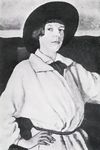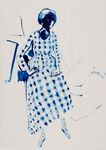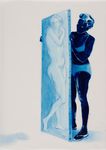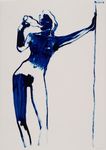How Lisa Brice set Nina Hamnett free - Stephen Friedman ...
←
→
Page content transcription
If your browser does not render page correctly, please read the page content below
Charleston
How Lisa Brice set Nina Hamnett Free
Katy Hessel
7 July 2021
How Lisa Brice set Nina Hamnett free
Image: Lisa Brice, Untitled, 2021. Oil on tracing paper, Copyright Lisa Brice.
Courtesy the artist; Stephen Friedman Gallery, London and Salon 94, New
York.
A woman stands over a mirror, naked, painting a likeness to Gustave
Courbet’s ‘The Origin of the World‘ (1866). Another, also nude, sits in a café
reminiscent of Edgar Degas’ ‘L’Absinthe‘ (c.1875). Her expression no longer
blank, but rather saddled with defiance, a glare in her eye. There’s also the
woman evoking the in-profile character in Felix Vallotton’s ‘La Blanche et
la Noire‘ (1913). She could be any one of the mighty, formidable women
smoking. And then there’s the figure in a long, chequered dress and thin,
cross-lace boots. This is Nina Hamnett, from Roger Fry’s portrait. Set free,
like the others, into the 21st century.
Image: Lisa Brice, Untitled, 2021. Oil on tracing paper, Copyright Lisa Brice.
Courtesy the artist; Stephen Friedman Gallery, London and Salon 94, New
York.
‘I like to think of her setting all these women free. Free from a history which
tried to suppress them, and instead unleashed into the wild as
commanders of the canvas.’
Commanding, unruly and powerful, Lisa Brice’s blue-toned works reinvent
figuration for their contemporary audience. Physically reincarnating
female characters from historic paintings, she charges them with power,
lifts them from passivity, removes their male chaperone (where necessary),
and fills them with determination. For me, it’s their forthright stares and
unfazed stances. Minding their own business her protagonists inhabit a
hot, hazy, liminal space, complete with a beer bottle, and/or cigarette
which they puff into a sea of rich blue textures. At times, Brice also gives
them a mirror, a canvas, a paintbrush, and palette as if rewriting themselves into history on their terms how they
would have wanted to be remembered: confident, defiant, dominant, strong.
25—28 Old Burlington Street London W1S 3AN
T +44 (0)20 7494 1434 stephenfriedman.comCharleston
How Lisa Brice set Nina Hamnett Free
Katy Hessel
7 July 2021
Image: Lisa Brice, Untitled, 2021. Oil on tracing paper, Copyright Lisa Brice.
Courtesy the artist; Stephen Friedman Gallery, London and Salon 94, New
York.
‘Brice has reincarnated her as an artist, not model: free from misogyny and
the objectification of the day.’
Working around a century apart, it makes sense for Brice to re-immortalise
Hamnett. Typically remembered by history as a model and muse, like most
Hamnett was ‘deadly serious’ about her art. A successful professional artist
working at the height of British and French Modernism, Hamnett captured
the spirit of the age with her angular still lifes and psychologically-charged
portraits. From dancers, writers and landladies to fellow artists, she painted
them with an unflinching gaze, and was unafraid to tackle the fully nude
male. Teeming with intensity, emotion, intimacy and expression, for me, the
work of Hamnett almost feels like a precursor to paintings by the great Alice Neel.
Image: Nina Hamnett, ‘The Landlady’, 1918. Courtesy: private collection;
photograph: Bridgeman Images.
Image: Nina Hamnett, Reclining Man, 1918. Private Collection.
Going beyond the surface of her subject and into their mind,
recording the encounter (tension has never been more present
than in ‘The Landlady’ (c.1917), Hamnett painted her
community and people from all walks of life. (I find a striking
familiarity between Hamnett’s ‘Reclining Man’ (1918), and
Neel’s ‘Ballet Dancer‘ (1950): their cramped bodies, and the
closeness of them). And like Neel with her bold, commanding
(some might say obnoxiously flattering… but who’s counting?)
‘Self Portrait‘ (1980), holding a paintbrush at aged 80,
Hamnett also portrayed herself as a controller of the canvas.
To our knowledge, her self portraits are lost with only images now existing. All that remains are the portraits of
her by men. That is, until now.
25—28 Old Burlington Street London W1S 3AN
T +44 (0)20 7494 1434 stephenfriedman.comCharleston
How Lisa Brice set Nina Hamnett Free
Katy Hessel
7 July 2021
Image: Nina Hamnett, Self-portrait, 1913; Published in Colour magazine,
June 1915
As if to liberate her from the male-gaze-controlled lens, Lisa Brice has
re-immortalised Hamnett’s ‘Self Portrait’ (1913) as one of her blue works.
No longer remembered as the gaunt, androgynous model, Brice has re-
introduced Hamnett to her 21st century audience. Fully clothed, her hand
on hip, sporting a large hat and with her arm off to the side (as if applying
paint to canvas), which she does exuding confidence, Brice has
reincarnated her as an artist, not model: free from misogyny and the
objectification of the day. Or, take Hamnett as the bronze nude by Henri
Gaudier-Brzeska, which we meet in the Spotlight Gallery between the
two exhibitions. As if to take ownership of how he sculpted her, Brice has
a nude model (who I like to think of as Hamnett) parade in a similar pose,
to reclaim his gaze. Taking Hamnett’s sketches and recasting them in
canvases taller than her body, she also presents Hamnett with the work
she would have been offered had she had the opportunity in her day.
Image: Lisa Brice, Untitled, 2021. Oil on tracing paper, Copyright Lisa
Brice. Courtesy the artist; Stephen Friedman Gallery, London and Salon
94, New York.
Existing in what Brice refers to as the ‘gloaming hour’ (when day becomes
night), I like to think of her setting all these women free. Free from a
history which tried to suppress them, and instead unleashed into the wild
as commanders of the canvas.
25—28 Old Burlington Street London W1S 3AN
T +44 (0)20 7494 1434 stephenfriedman.comYou can also read
























































